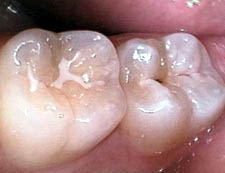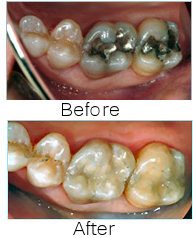Crowns or Bridges
 A dental bridge is a fixed (non-removable) appliance and is an excellent way to replace missing teeth.
A dental bridge is a fixed (non-removable) appliance and is an excellent way to replace missing teeth.
There are several types of bridges. We will discuss the best options for your particular case. The “traditional bridge” is the most popular type and is usually made of porcelain fused to metal. This type of bridge consists to two crowns that go over two anchoring teeth (abutment teeth) and are attached to pontics (artificial teeth), filling the gap created by one or more missing teeth.
Dental bridges are highly durable and will last many years, however they may need replacement or need to be re-cemented due to normal wear.
Reasons for a fixed bridge:
- Fill space of missing teeth.
- Maintain facial shape.
- Prevent remaining teeth from drifting out of position.
- Restore chewing and speaking ability.
- Restore your smile.
- Upgrade from a removable partial denture to a permanent dental appliance.
What does getting a fixed bridge involve?
 Getting a bridge usually requires two or more visits. While the teeth are numb, the two anchoring teeth are prepared by removing a portion of enamel to allow for a crown. Next, a highly accurate impression (mold) is made which will be sent to a dental laboratory where the bridge will be fabricated. In addition, a temporary bridge will be made and worn for several weeks until your next appointment.
Getting a bridge usually requires two or more visits. While the teeth are numb, the two anchoring teeth are prepared by removing a portion of enamel to allow for a crown. Next, a highly accurate impression (mold) is made which will be sent to a dental laboratory where the bridge will be fabricated. In addition, a temporary bridge will be made and worn for several weeks until your next appointment.
At the second visit, you permanent bridge will be carefully checked, adjusted, and cemented to achieve a proper fit. Occasionally your dentist may only temporarily cement the bridge, allowing your teeth and tissue time to get used to the new bridge. The new bridge will be permanently cemented at a later time.
You will receive care instructions at the conclusion of the procedure. Proper brushing, flossing and regular dental visits will aid in the life of your new permanent bridge.
Call our office to schedule an appointment today.
(757) 425 1828
Extractions
 Good oral hygiene should always be practiced since the loss of a single tooth can have major impact upon your oral health and appearance. Although dentists will use every measure to prevent tooth loss, there still sometimes necessary occasions when a tooth may need to be extracted. A tooth may need to be extracted for the following reasons:
Good oral hygiene should always be practiced since the loss of a single tooth can have major impact upon your oral health and appearance. Although dentists will use every measure to prevent tooth loss, there still sometimes necessary occasions when a tooth may need to be extracted. A tooth may need to be extracted for the following reasons:
-
- Severe decay
- Advanced periodontal disease
- Infection or abcess
- Orthodontic correction
- Malpositioned teeth
- Fractured teeth or roots
- Impacted teeth
After careful examination and treatment, the dentist may advise to have a tooth extracted. Before a tooth is removed, the dentist will take an x-ray in order to understand the shape and position of the tooth and surrounding bone. Based on the degree of difficulty, we may refer you to a specialized oral surgeon.
Call our office to schedule an appointment today.
(757) 425 1828
Sealants
What Are Sealants?
 Dental sealants are thin plastic coatings that are applied to the chewing surfaces of the back teeth to prevent decay. Most tooth decay in children and adolescents occurs on the chewing surfaces of these back teeth, which are called molars. This is because molars have irregular surfaces with pits and grooves, which tend to trap food and bacteria debris. Sealants flow into and coat these pits and grooves so that bacteria cannot multiply and cause decay.
Dental sealants are thin plastic coatings that are applied to the chewing surfaces of the back teeth to prevent decay. Most tooth decay in children and adolescents occurs on the chewing surfaces of these back teeth, which are called molars. This is because molars have irregular surfaces with pits and grooves, which tend to trap food and bacteria debris. Sealants flow into and coat these pits and grooves so that bacteria cannot multiply and cause decay.
Why is sealing a tooth better than filling a cavity?
Sealants help maintain sound teeth. Decay destroys the structure of the tooth. Each time a tooth Is filled or a filling is replaces, additional tooth structure is lost. Amalgam fillings last an average of six to eight years before they need to be replaced. Appropriate use of sealants can save time, money and the discomfort associated with restorative dental procedures.
How are sealants applied?
Applying sealants is quite simple. First, the teeth are cleaned. Then the teeth to be sealed are dabbed with a very mild acid solution similar in strength to vinegar or lemon juice. This roughens the tooth surface very slightly so that the sealant will bond to it properly. After the tooth is prepared, the sealant is painted onto the tooth. It flows into the pits and grooves and hardens in about 60 seconds. After sealing, bacteria cannot reach the pits and groove, and therefore cannot cause decay. Applying sealants requires no drilling or removal of the tooth surface. Tooth structure is left intact – healthy teeth are protected from decay-forming bacteria.
How long will dental sealants last?
A sealant application can last for as long as five years and often longer. Sealants should be checked regularly and reapplied when they appear to have worn off. Because teeth are most susceptible to decay when they are young, preventing decay during the first 5 to 14 years after a tooth erupts is critical.
How do sealants fit into a preventive dentistry program?
For maximum benefit, sealants should be used as part of a child’s total preventive dental care. A dentist should examine the child’s teeth and gums regularly to check bite, tooth eruption, and the condition of both hard and soft tissues. A complete preventive dentistry program also includes: brushing and flossing, use of fluorides, good nutrition and regular dental checkups.
Do sealants cost more than fillings?
The cost of sealing a tooth is consistently less than the cost of having a tooth filled
Will sealings replace fluoride?
NO! Fluorides such as those used in fluoridated water, fluoride toothpaste, and fluoride mouth rinse help prevent decay on the smooth surfaces of teeth. However, fluorides have less effect on the rough, pitted chewing surfaces of the back teeth where food particles and decay-producing bacteria are trapped. Sealants, however, are only effective on the uneven chewing surfaces.
Have sealants been thoroughly tested?
YES! Thousands of children across the United States and in other countries have had their teeth sealed in controlled clinical studies. These studies have shown sealants to be effective, easy to apply, inexpensive and non-toxic. That’s why the American Dental Association, the National Institute of Dental Research and the American Public Health Association have recommended sealants.
Tooth Colored Restorations
 Gone are the days when tooth ailments and cavities could only be treated with unsightly metal fillings. Today, modern, tooth-colored fillings made of durable resin or porcelain can be bonded to your teeth for a stronger, more natural-looking effect. These revolutionary fillings are virtually undetectable and are easy to apply.
Gone are the days when tooth ailments and cavities could only be treated with unsightly metal fillings. Today, modern, tooth-colored fillings made of durable resin or porcelain can be bonded to your teeth for a stronger, more natural-looking effect. These revolutionary fillings are virtually undetectable and are easy to apply.
To find out if tooth-colored fillings are a good option for you, please contact us today.

Please Call our Office Today! (757) 425-1828

